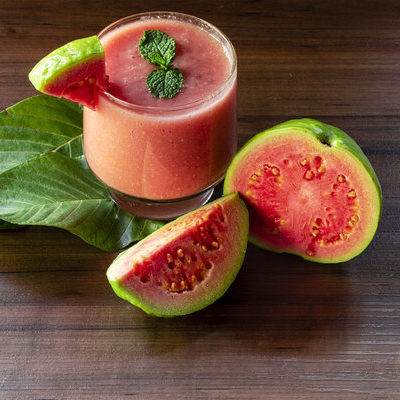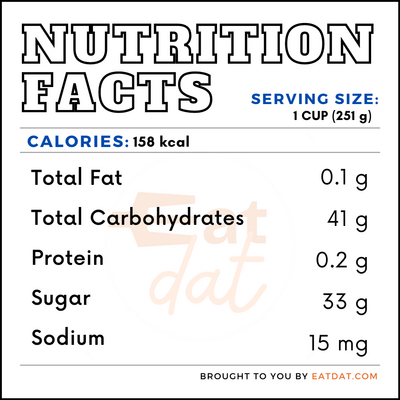
Guava Juice
What is Guava Juice?
Guava juice is the juice obtained by the squeezing, pressing, or crushing of the pulp of the guava fruit. Guava is a tropical fruit that may be either round or oval in shape. The outer skin is green in color and the inside flesh is pink or white with crunchy seeds.
- The fruit tastes sweet and has a strong fruity odor.
- The name guava most likely came from ‘guayabo’, a word meaning ‘guava tree’ in the South American Arawak language.
The top guava-producing countries in the world are:
- India
- China
- Thailand
- Pakistan
- Mexico
- Indonesia
- Brazil
- Bangladesh
- Philippines
- Nigeria
Origin of guava juice
This fruit originated in Central and South America. This fruit is an integral part of Mexican and other Central American cuisines. Mexicans tribes have long been using guava as a traditional treatment for diarrhea and dysentery. The Spanish and Portuguese colonizers brought the fruit back to Europe, and from there, disseminated it throughout the world. Today, it is popularly grown in tropical regions around the world.
Nutrition
Guava juice has several health benefits. One cup of guava juice can give you:

Despite its sugar content, it is effective in regulating blood sugar. It also helps in keeping cholesterol, triglycerides, and LDLc down while increasing the HDLc levels. Guava has anti-oxidative and anti-inflammatory properties because of its high levels of vitamin C, flavonoids, and polyphenols. This fruit juice also contains carotenoids, vitamin A, calcium, and iron in decent quantities. Regularly consuming guava can increase the bioavailability of iron among vegetarians.
Commercial production
Most guava produced is consumed fresh. Guava juices can be either clarified or cloudy. It is not common to use many enzymes to promote either clarification or cloudiness. However, they may contain pectinases, arabinose, and cellulase.
The commercial production begins with the selection of ripe guavas without any bruising. The fruits, once crushed, undergo enzyme treatment and then centrifugation for removing particles. The juice is then filtered and pasteurized to get rid of bacteria. After, the juice is either packaged or sent off for further processing to condense it into concentrates. The juice may also be freeze dried, spray dried, or tunnel dried to make it into flakes or powder.
Guava juice can be made fresh at home or store-bought. Freshly squeezed guava juice may be stored in the refrigerator for up to 48 hours. Commercially produced pasteurized juice can last for up to three months, as long as it is kept unopened.
Guava juice recipes
This fruit juice is used in many cuisines, especially in drinks and desserts. Here are a few recipes to get you started:
- Perad
- Chilli Guava Juice
- Guava Jelly
- Guava Cake
- Macuá
- Hawaiian Guava Cake
- Guava Citrus Marinated Grilled Pork Chops
FDA regulations
The FDA strictly regulates the growing, harvesting, packing, and holding of guavas, as well as ensure the safety of guava juice. The preparation of guava jelly, preserves, and jams are also regulated. The FDA requires at least 7.7 percent concentration in commercial guava juice.
References
S.P. Singh, 10 – Guava (Psidium guajava L.), Editor(s): Elhadi M. Yahia, In Woodhead Publishing Series in Food Science, Technology and Nutrition, Postharvest Biology and Technology of Tropical and Subtropical Fruits, Woodhead Publishing, 2011, Pages 213-246e, ISBN 9781845697358, https://doi.org/10.1533/9780857092885.213. http://www.sciencedirect.com/science/article/pii/B9781845697358500103
Chetan A. Chopda & Diane M. Barrett, Optimization of Guava Juice and Powder Production, Department of Food Science and Technology University of California Davis, Davis, Ca 95616-8589, https://Ucanr.Edu/Sites/Postharvest_Technology_Center_/Files/231599.Pdf
Kumari, Suchitra et al. “Effect of Guava in Blood Glucose and Lipid Profile in Healthy Human Subjects: A Randomized Controlled Study.” Journal of clinical and diagnostic research : JCDR vol. 10,9 (2016): BC04-BC07. doi:10.7860/JCDR/2016/21291.8425, https://www.ncbi.nlm.nih.gov/pmc/articles/PMC5071920/
Lin, Chia-Fa et al. “Quercetin-Rich Guava (Psidium guajava) Juice in Combination with Trehalose Reduces Autophagy, Apoptosis and Pyroptosis Formation in the Kidney and Pancreas of Type II Diabetic Rats.” Molecules (Basel, Switzerland) vol. 21,3 334. 10 Mar. 2016, doi:10.3390/molecules21030334, https://www.ncbi.nlm.nih.gov/pmc/articles/PMC6274302/
Nair, Krishnapillai Madhavan et al. “Inclusion of guava enhances non-heme iron bioavailability but not fractional zinc absorption from a rice-based meal in adolescents.” The Journal of nutrition vol. 143,6 (2013): 852-8. doi:10.3945/jn.112.171702, https://www.ncbi.nlm.nih.gov/pmc/articles/PMC3652882/
